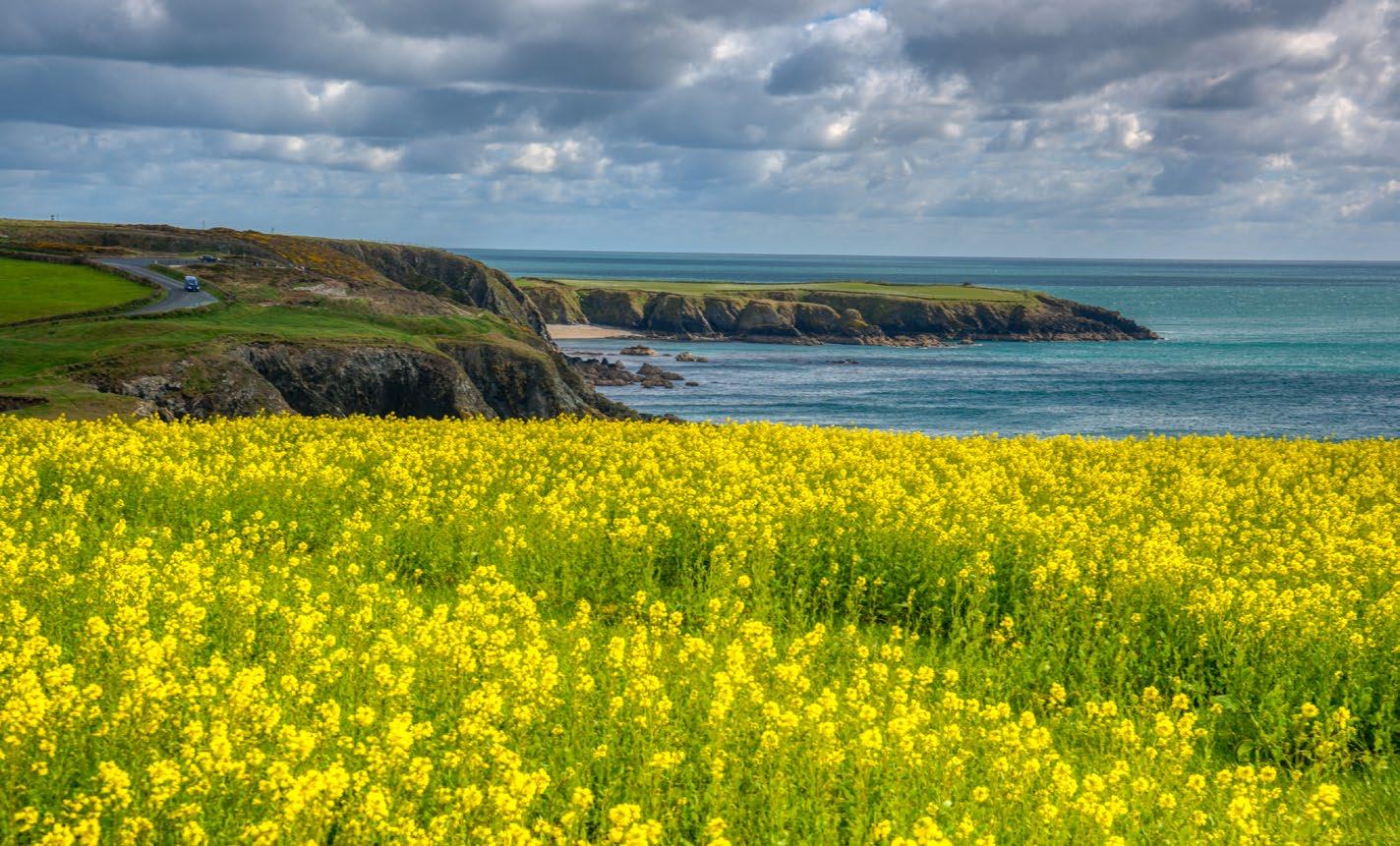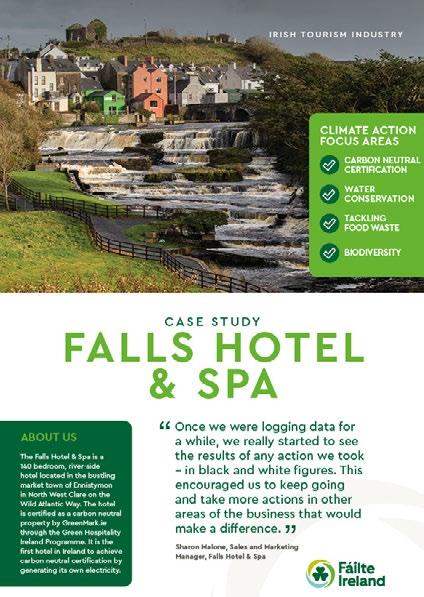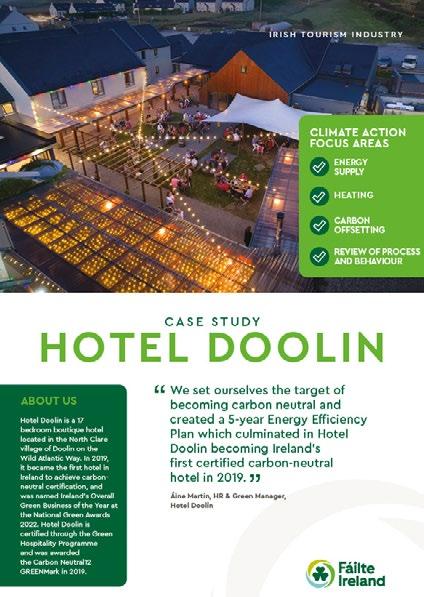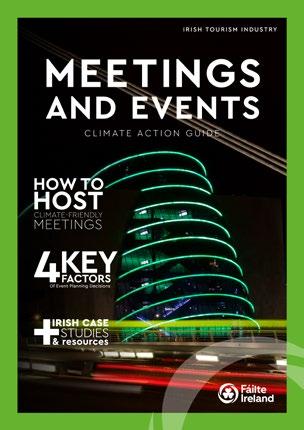








Joining the global fight against climate change, Ireland has committed to cutting greenhouse gas emissions in half by 2030, and to achieving net-zero emissions by 2050.
The Energy, Water and Waste Management guides in this series help you with reducing direct emissions from your business. The priority is to reduce direct and indirect emissions, but it is widely agreed that most businesses will not reach net-zero emissions purely through reduction strategies. There will always be some emissions that you cannot reduce to zero, but offsetting can help when reduction is not possible.
In this guide, we provide advice for tourism and hospitality businesses who wish to complement their reduction strategies by offsetting emissions.

Let’s get started.
THE ACTIONS IN THIS GUIDE CONTRIBUTE TO SUSTAINABLE DEVELOPMENT GOAL 13.
This useful Carbon Calculator can help you establish the carbon footprint of your business. Find out about the Climate Toolkit 4 Business here.

Carbon offsetting is where funds are directed to projects that help reduce global emissions, allowing individuals or organisations to compensate for the CO2e emissions they have produced.

THIS IS ACHIEVED BY SUPPORTING SCHEMES THAT: Remove CO2e emissions from the atmosphere e.g., planting trees that absorb CO2e from the atmosphere.
Reduce the number of emissions that will be produced in the future e.g. delivering energy-efficient projects to communities in developing countries.
It’s important to remember that emissions must be reduced as much as possible BEFORE offsetting carbon. Offsets should be applied only to emissions that cannot otherwise be reduced or eliminated.
GREENHOUSE GASES (GHGS)
These are gases in the earth's atmosphere that allow the sun's rays to pass through and warm the planet, but prevent the warmth escaping from the atmosphere into space. Without them, Earth would be too cold to sustain life. There are several different greenhouse gases: carbon dioxide, methane, nitrous oxide, and ozone. The gases have different impacts on global warming - methane has about 23 times the impact of carbon dioxide.
What is carbon offsetting?AVONDALE HOUSE AND TREETOP WALK, CO. WICKLOW
Another thing to watch out for is ‘greenwashing. Greenwashing is when a company claims, through its marketing communications, to be more environmentally conscious and responsible
than it actually is in practice. Greenwashing misleads customers through exaggerated claims of the environmental benefits that derive from products, services or company actions.
CO2: CARBON DIOXIDE
As it’s the most prevalent gas (after water vapour), it has become the proxy by which we speak about and measure greenhouse gas emissions.
CO2E: CARBON DIOXIDE EQUIVALENT
CO2e is a way of measuring all the emissions of all the greenhouses gases by telling us what impact the emissions would have if they were all carbon dioxide. When you see a carbon footprint expressed in terms of CO2e, you know that all greenhouse gases have been included.
Hotel Doolin is a certified carbon neutral hotel in Co. Clare. In 2017, the on-site carbon footprint of the hotel was 461 tonnes and by 2021, the on-site carbon footprint had been reduced to 68 tonnes.

The remaining carbon was offset through planting native trees locally. In the three years up to 2022, Hotel Doolin had planted 2060 native trees locally which will offset 2060 tonnes of carbon over their lifetime. For every wedding that takes place at the hotel, 10 native trees are planted locally. 2021 weddings alone committed Hotel Doolin to planting 710 native trees.

'Net Zero' is the point where there is balance between the carbon/CO2e emitted into the atmosphere and the carbon/ CO2e removed from it. The overall aim of net zero is not to stop all emissions but to remove as much as we put in. Achieving this will stop global temperatures rising.
There is an opportunity to build on this objective and
remove more than we put in. This could help reverse the global temperature rises we have already seen (or will have seen by 2050).
The focus is to: reduce emissions to as close to zero as possible offset remaining residual emissions that cannot be reduced by other

VISION Achieve net-zero by 2050.
STRATEGY Reduce emissions as much as possible, offset what cannot be reduced.
PATHWAYS How we will get to net-zero by 2050.

Carbon offsetting plays an important role in fighting climate change. While reduction is the priority, offsetting should be considered throughout the journey as a combination of reducing and offsetting gives the best results.
Greenhouse gases will continue to be put into the atmosphere for
decades to come. Offsetting helps minimise future emissions and build additional capacity in the Earth’s natural carbon sinks.
Reaching the ‘Net-Zero by 2050’ target is a huge task and there are major constraints. Most notably, there is insufficient data, data collection options and insufficient technology.
Not all emissions can easily be measured or reduced at this time and so, the solution is to offset while the means to reduce are being developed.
For the next two decades, businesses that follow a net-zero pathway can focus on making reductions to their emissions, while offsetting those that remain.
Why should your business consider carbon offsetting?
To kickstart your carbon offsetting journey, implement these four key steps:

STEP 01 Calculate your emissions
STEP 02 Commit to reducing emissions and take action
STEP 03 Choose an offset programme
STEP 04 Report and review
The first step is to measure your organisation’s CO2e footprint as accurately as possible. See the Climate Action Roadmap for resources to help you identify what you should be measuring and how to measure it.
This allows you to establish the offsets you wish to purchase. Whichever method you use to calculate carbon footprint, keep a record of how you reached your total. Highlight any areas you are unable to measure accurately, and why this was the case.
This useful Carbon Calculator can help you establish the carbon footprint of your business. Find out about the Climate Toolkit 4 Business here
A key step in any offsetting project, but especially important for a netzero pathway, is committing to reducing your emissions. This must be done before any offsetting is pursued. Offsetting should only ever be applied to emissions that cannot be otherwise reduced or eliminated.
This means setting defined reduction targets and taking action to achieve them. Consider using SMART goals to set your targets making sure they are specific, measurable, achievable, realistic and time bound. This helps to set manageable targets and track progress in detail.
Find details on recommended approaches and techniques for reducing emissions in our energy, waste, and water guides.
Choose an offset programme that aligns with your brand and vision. Some businesses choose to support local initiatives, while others support offsetting programmes in developing countries. There is no set list of offsetting projects to draw from and, as yet, no universal standard of verification.
Ensure the offset project or scheme you choose is both reputable and verifiable. Seek out a project or scheme that can provide you with transparent reports and methodologies. Make sure that you can verify and account for the carbon emissions being saved.
If you are following a net zero pathway, remember that different pathways have different
requirements when it comes to offsetting, in terms of what you can offset and on what offsets you can use. Refer to your chosen pathway before selecting an offset programme for your organisation.
Honesty and transparency are key aspects of carbon offsetting. There may be areas you are unable to accurately measure or are unable to reduce.
Undertaking regular reviews, providing updates on progress, and highlighting any issues you have encountered, will help to alleviate fears of greenwashing and prevent any negative feedback.
To offset carbon emissions that could not be reduced in any other way, Falls Hotel & Spa Ennistymon planted approximately 500 native trees on their hotel grounds during 2020-21.
Each tree offsets 1 tonne of carbon in its lifetime. This was the final step in the hotel’s journey to carbon-neutral certification.


For more ideas to engage your team and sustain momentum, check out the How To Tell Your Climate Action Story Guide.
Your clients, customers and community are aware of climate change and its impacts. Sharing your efforts to engage in carbon offsetting, through social media, local press, and your own website, is a great way to engage with your stakeholders.

Check out these supports and resources to help you on your climate action journey.


Check out a comprehensive range of climate action and business supports and resources for the Irish tourism industry.
Find Out More
Read up on greenhouse gas accounting standards, upon which the emerging pathways are based. Read More
The SBTi’s Net-Zero Standard provides the guidance and tools for companies wishing to set and meet science-based net-zero targets.
Read More
Discover the climate and environmental action section of the WTTC, including the WTTC report A Net Zero Roadmap for Travel and Tourism.
Read More
Get details on the Climate Action plan 2021. Read More
Learn how to use carbon offsets in voluntary greenhouse gas reduction strategies. Get Guide
Learn from Irish and international businesses about their climate action journey. Get inspiration and top tips.
Explore our series of guides as part of Fáilte Ireland’s Driving Action on Climate Change in tourism businesses. You can find links to all the others in the series to help you on your climate action journey here.


Explore our key tool designed to help you navigate the climate action journey of cost and carbon reduction.
Just click on the covers below to access each guide in our series.

Learn how minimising energy consumption using renewable energy alternatives will save costs and reduce carbon emissions.

Explore our guide for suggestions on how your business can reduce water consumption, resulting in a lower water bill.
Find out how waste management can reduce your carbon footprint which can directly lead to cost-savings.



Learn how to promote your Climate Action initiatives to the consumer.


Find out how enhancing biodiversity in your business or location is a great place to start actioning climate change.
Learn how to run a climate-friendly meeting or event that incorporates environmental considerations.
Discover more about the importance of festivals for climate action from applying influence and inspiration to engaging with audiences.
